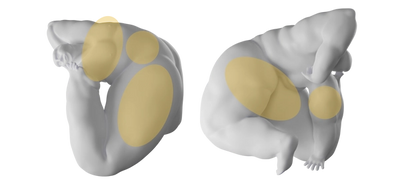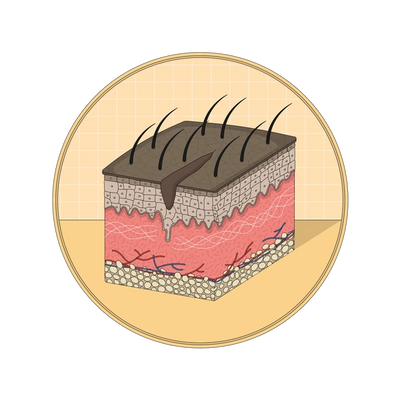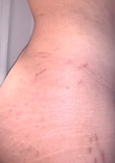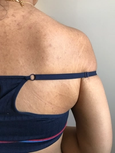Stretch Marks
strech –maarksStretch marks are long, jagged streaks where the skin has slightly torn, usually from sudden weight or muscle gain or pregnancy.
Also Called
Striae distensae, striae gravidarum, striae rubra, striae albae
Frequently Found On
Upper arms, breasts, butt, abdomen, hips, thighs

What are stretch marks?
Stretch marks are areas of the skin that have stretched, typically as a result of weight gain, pregnancy, or muscle growth, and left a mark that looks like a jagged tear.
“When you get a stretch mark, it’s basically because the collagen production below the surface of your skin cannot keep up with the expansion of the top-most layer of your skin,” explains Dr. Shirley Chi, a board-certified dermatologist at the Center for Advanced Dermatology in Arcadia, CA. “The top-most layers of your skin have some elasticity to them and so they’ll stretch to a degree, but if you gain weight too quickly, through pregnancy or even bodybuilding, then you’re not creating enough collagen to make up for that expansion.”
Stretch marks can show up in a range of colors and distribution. You might have one or three subtle pink stretch marks on your thighs, or what looks like a webbing of scarlet slashes on your stomach or shoulders. Doctors call the lines “striae,” (and the medical term for stretch marks is striae distensae) but you can save that for the next time you get too many vowels in Scrabble.
“Some people have very light stretch marks,” says Dr. Chi, “some have very deep stretch marks. And some people have just one on their butt.” Some are red, purple, or brown, depending on your skin color, but the difference in color doesn’t signal anything meaningful—a purple mark isn’t more severe than a brown one—that’s just one of the many ways our bodies like to keep things interesting. Stretch marks can deepen and expand if the skin continues to stretch, while others may fade into white lines (called striae albae) over time.

There are a variety of causes of stretch marks and that will usually dictate how a dermatologist recommends treatment. Preventing stretch marks and treating them when they’re early is ideal before they get a chance to deepen. Talk to your doctor if you’re concerned about potential stretch marks or want to treat some you already have.
Stretch marks aren’t harmful or dangerous to your overall health, it’s a cosmetic issue. You can choose to treat it, and there are a handful of options from lasers to microneedling, or you can 100 percent ignore them. All valid options. “Don’t give yourself a hard time if this is just your natural, genetic predisposition,” says Dr. Chi. “You can do your best and you can go seek help, but don’t beat yourself up about stretch marks.”
What causes stretch marks?
The main cause of stretch marks is rapid weight gain that requires the skin to stretch to accommodate that added weight. The faster the body gains that weight, the more likely the stretch marks appear. Stretch marks are common during pregnancy, among bodybuilders, teenagers experiencing growth spurts, and people who’ve simply gained weight. The reason for the weight gain might reflect where the stretch marks appear (a pregnant woman’s stomach, a bodybuilder’s recently jacked biceps, breasts after implant surgery, etc.), but otherwise they tend to show up in areas where we store fat, like the thighs, butt, and stomach.
“It’s like a slow tear,” says Dr. Shirley Chi. “Your skin is expanding but you’re not creating enough filler substance in between the expanding parts to keep it smooth.”
What’s happening, she explains, is the skin can’t keep up with the sudden growth. Usually, collagen and elastin underneath the top layers of skin keep it smooth and stretchy, but if those proteins can’t keep up with how fast the skin is growing, it’ll stretch and leave marks.
There are also medication-related stretch marks, usually brought on by topical corticosteroids (steroids) “If you use a steroid cream on your armpits, neck, genitals, anywhere where skin is kind of touching skin,“ notes Dr. Chi, “those areas can quickly develop stretch marks because the steroid is thinning out the skin in those areas.”
Similarly, medical conditions like Cushing’s syndrome and Marfan syndrome increase the hormone cortisol in the body, which ends up thinning the skin like steroid creams do.
“I think people sometimes feel like they did something wrong,” says Dr. Chi, “and they shouldn’t feel like that because a lot of it is hereditary. How quickly you can form collagen is, to a large degree, just dictated by your genes. So if your mom got stretch marks at some point in her life, then it's very likely that you will have some.”
How do you treat stretch marks?
Treating stretch marks depends on the person, period. “It’s got to be personalized,” says Dr. Shirley Chi. “But the key is you’ve got to go in early”—before the stretch marks deepen, which will take more time and effort to treat.
In one study, 90% of the patients with stretch marks tried to treat them with over-the-counter creams, and only 9% saw improvement.1 So when it comes to treating stretch marks, if you can, go for the big guns: prescription retinoid creams and cosmetic procedures like laser therapy, which shows the most improvement in stretch marks (42% in one study).2 The downside is that because they’re considered cosmetic, laser therapies can be expensive and not covered by insurance.
Depending on the patient, Dr. Chi might prescribe a retinoid cream, like Tesseract or Tretinoin, along with microneedling or a laser treatment like Fraxel Re:pair, to treat stretch marks. “Retinoids go into your cellular DNA and they up-regulate, in other words, they increase your collagen production from a cellular level,” she explains. Lately, she often turns to microneedling.
“I think microneedling is sort of the new fractional laser,” says Dr. Chi. “It’s less expensive. It's for all skin types, and it’s not heat-based so it doesn't cause as many discoloration issues. In darker skin types, if you do too strong of a laser treatment, you can cause post-inflammatory darkness or hyperpigmentation issues.”
Microneedling is what it sounds like: super thin needles are carefully inserted into the skin to stimulate the skin’s own self healing, which ends up sparking collagen and elastin production. Studies have found that microneedling can improve the appearance of stretch marks better than microdermabrasion, which is more of an intense exfoliation.3 Laser treatments (like pulsed light, fractional lasers, and bipolar radiofrequency) also have evidence of improving stretch marks, though the truth is, no treatment has been able to completely get rid of stretch marks; there’s usually a small or faint line that remains.4
So one stretch mark treatment plan Dr. Chi might recommend: Microneedling, a strong retinoid, and then making sure that the patient moisturizes with a heavy-duty moisturizer like Shea butter. But every person’s skin is different, and the context of their stretch marks might require a completely different approach. As always, talk to your doctor or a cosmetic dermatologist about the best route for your skin.
How do you prevent stretch marks?
“To a large degree, stretch marks are somewhat hereditary,” says Dr. Shirley Chi. So that element of preventing stretch marks is unavoidable.
You can try to prevent stretch marks by keeping the skin elastic and hydrated with thick moisturizers and body creams (not lotions, which are water-based) that keep the skin’s texture smooth and able to stretch when needed, says Dr. Chi. “It’s really just to keep your skin elasticity soft so that it’s not firm and more breakable. Moisturizing is more for stretch mark prevention. It’s definitely not for treatment.” The American Academy of Dermatology recommends taking the time to massage moisturizers in, which may make them more effective.5
Dr. Chi recommends shea butter, which is thick and oil-based. Cocoa butter may help too. “Hyaluronic acid might help prevent stretch marks in the same way that shea butter does, but it’s water-based, so it doesn't clog pores (and is good on the face). But since this is on your body, you just want heavy-duty stuff, you know?”
For pregnant women or anyone in a period of transition with their weight, keep an eye on the skin and notice when early signs of stretch marks show. “It might be a pink, little line that looks like a little crack in the skin, or you might have a little cluster of pink lines,” says Dr. Chi. “If you're pregnant, you're going to do really intense moisturization and watch your weight gain. The most important thing, actually, is to gain weight slowly.”
Certain body oils, like the drugstore standby Bio-Oil, are popular for stretch mark prevention. Bio-Oil is a combination of Vitamin A (naturally occurring retinol), Vitamin E (hydrating), and anti-inflammatory plant essential oils. But it’s hard to make any promises. The data that’s out there depends on surveys, which reveal that Bio-Oil is the most popular product used by pregnant women to prevent stretch marks, but the only evidence that it improves skin conditions comes from the company’s own surveys.6
Some studies show that moisturizing treatments can help stretch marks from becoming more severe, while on the whole, medical evidence that topical treatments can prevent stretch marks is debatable,7 with some studies finding they don’t work at all.8 Though because they’re not dangerous, stretch marks aren’t the subject of a lot of studies. Enough people swear by almond oil, olive oil, or cocoa butter to fill the aisles of the drugstore, but there’s no guarantee those work.
Sometimes genetics overpower any amount of moisturizing—frustrating—and it becomes time to look into treating stretch marks rather than preventing them.
Citations
1,2Stretch marks and treatment efficacies by the American Academy of Dermatology Association.
3,4,7Management of stretch marks (with a focus on striae rubrae) by Uwe Wollina, MD and Alberto Goldman. J Cutan Aesthet Surg.
5Stretch Marks: Why They Appear and How to Get Rid of Them by the American Academy of Dermatology Association.
6The use of anti stretch marks’ products by women in pregnancy: a descriptive, cross-sectional survey by Miriam Brennan et al. BMC Pregnancy Childbirth.
8Striae distensae: a comprehensive review and evidence-based evaluation of prophylaxis and treatment by S Al-Himdani et al. Br J Dermatol.
Get Updates
There’s more to come.
Sign up to receive periodical updates on Mass Index, and to be the first to know when Soft Services launches new products. (If we don’t have any updates, we won’t email you.)






















